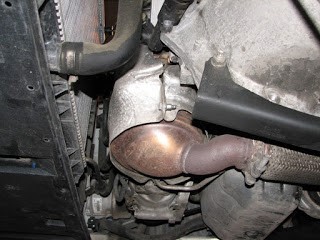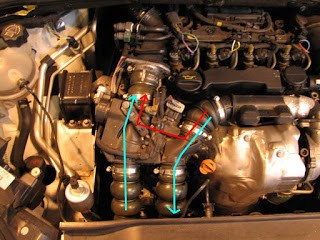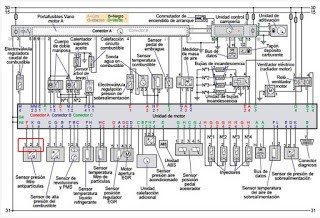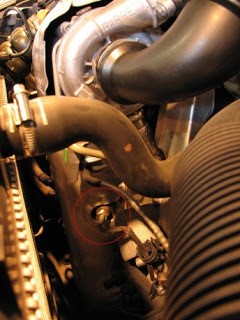 |
| Particulate filter |
For this, we are going to have the assistance of the documentation provided by the www.dis-net.com platform and take the Peugeot 308 1.6 HDI as an example.
The particulate filter is a component that reduces pollution in vehicles equipped with a diesel engine by filtering the solid particulates from the exhaust gas.
Over time, the filter becomes blocked due to the accumulation of these
particulates, ash from the engine oil and other residues. By means of a process
called regeneration, the anti-particulate filter burns these residues
and thus increases its efficiency.
The regeneration of the particulate filter is controlled by the engine injection unit.
This unit's software:
• Controls the post-injections required for the forced regeneration of the particulate filter so as not to excessively increase consumption or impregnate it with oil.
• Ensures the regeneration process is carried out at the optimum moment.
The engine control unit calculates the saturation of the particulate filter depending on the use of the vehicle, for this it compares the vehicle speed with the engine torque.
The back pressure sensor is a safety element that activates filter regeneration if the calculations are wrong and the filter becomes saturated earlier than predicted.
The accumulated particulates can burn naturally when the optimal temperature (approximately 500° C) is reached due to a heavy engine load for three minutes.
If the above conditions are not met, the engine management system is capable of assisting regeneration by acting on the following points:
- Increase of the electrical consumption of the vehicle: this is intended to increase the resistant torque of the alternator, and thus increase the torque and temperature of the engine.
- The heated rear window, the electric fan at the lowest speed, electric fan at medium speed and the glow plugs are the electrical loads that are activated (in that order).
The regeneration of the particulate filter is controlled by the engine injection unit.
This unit's software:
• Controls the post-injections required for the forced regeneration of the particulate filter so as not to excessively increase consumption or impregnate it with oil.
• Ensures the regeneration process is carried out at the optimum moment.
The engine control unit calculates the saturation of the particulate filter depending on the use of the vehicle, for this it compares the vehicle speed with the engine torque.
The back pressure sensor is a safety element that activates filter regeneration if the calculations are wrong and the filter becomes saturated earlier than predicted.
The accumulated particulates can burn naturally when the optimal temperature (approximately 500° C) is reached due to a heavy engine load for three minutes.
If the above conditions are not met, the engine management system is capable of assisting regeneration by acting on the following points:
- Increase of the electrical consumption of the vehicle: this is intended to increase the resistant torque of the alternator, and thus increase the torque and temperature of the engine.
- The heated rear window, the electric fan at the lowest speed, electric fan at medium speed and the glow plugs are the electrical loads that are activated (in that order).
- Overriding of the intercooler by means of the double throttle air doser: the reduction of the aspirated air density reduces the performance of the engine and consequently increases the temperature of the exhaust gas.
 |
| Red: Movement of air with regeneration / Blue: Without regeneration |
- The engine management system carries out post-injections in order to increase the temperature at the particulate filter inlet.
In order to facilitate the regeneration process and to save fuel in post-injections, Eolys is added to the fuel (compound based on cerine). This additive lowers the temperature at which the regeneration of the particulate filter starts: from 550°C down to 450°C.
The additive system consists of an electric pump controlled by the engine management unit which injects the cerine from its tank to the fuel tank by means of an injector. The cerine is injected during each refuelling and the injected quantity depends on the number of litres added during refuelling. It is calculated each time the fuel cap is opened and closed (the cap has a built-in presence sensor).
While the engine is running, the Common rail injectors inject the fuel and cerine mixture. The fuel is burnt inside the engine while the cerine passes through to the exhaust system and is deposited on the particulate filter to facilitate its regeneration.
NOTE: To ensure optimal operation of the particulate filter and to prevent its premature deterioration, engine oils must the used with a low phosphated ash, phosphorus and sulphur content.
Fault symptom
- The MIL comes on and the message "Anti-pollution system defective" appears on the central screen.
- Anomalies during driving: Engine noise, jerking, lack of power, engine stalling, etc.
- The vehicle is difficult to start.
First steps:
- Verify the user's complaint.
- The diagnostics machine may indicate the following fault codes:
P0470: Exhaust system back pressure sensor signal:Back pressure out of range on starting.
P0472 / P0473: Exhaust back pressure sensor signal: Short-circuit to
ground/short-circuit to battery positive.
P1447: Exhaust system back pressure sensor signal: Particulate filter
clogged.
P1457: Particulate filter defect Particulate filter holed or missing.
P1490: Regeneration not completed: Regeneration demand too frequent.
P2031: Temperature signal from the rear of the catalytic converter:
Temperature implausible before starting the engine.
P2032 / P2033: Temperature signal at the rear of the catalytic converter:
Voltage too low / Voltage too high.
Possible causes
-
Fault in the exhaust gas recirculation (E.G.R) system.
- Obstruction of the particulate filter.
- Fault in the particulate filter back pressure sensor.
- Electrical connection problem.
- Particulate filter temperature sensor in poor condition.
- Fault in the additive system
- Obstruction of the particulate filter.
- Fault in the particulate filter back pressure sensor.
- Electrical connection problem.
- Particulate filter temperature sensor in poor condition.
- Fault in the additive system
Diagnostics
Clear all the faults and turn off the ignition for more than 20 seconds.
Start the engine again and drive the vehicle for about 20 minutes at a constant speed of 80 – 120 km/h in order to carry out a complete regeneration of the particulate filter. Try to reproduce the symptom so that the previously stored fault reappears to validate it.
Check that the joining hoses between the back pressure sensor and the particulate filter are not damaged or obstructed.
Check the back pressure sensor is operating correctly, to do this proceed as follows:
Start the engine again and drive the vehicle for about 20 minutes at a constant speed of 80 – 120 km/h in order to carry out a complete regeneration of the particulate filter. Try to reproduce the symptom so that the previously stored fault reappears to validate it.
Check that the joining hoses between the back pressure sensor and the particulate filter are not damaged or obstructed.
Check the back pressure sensor is operating correctly, to do this proceed as follows:
 |
| Electrical
diagram of the Peugeot 308 1.6 HDI injection system (www.dis-net.com) |
• Check the 5 V power supply between pins 2 and 3 of the sensor with the
ignition on.
• Check that there is a voltage of 0.5 V at pin 1 with the engine stopped (this
indicates a back pressure of 0 bar) (if this is not the value given, replace
the back pressure sensor).
• Start the engine and diagnose the condition of the particulate filter with the voltage reading:
• From 0.4 V to 1.0 V means that the particulate filter is in good condition.
• 4.1 volts corresponds to 0.9 bar of back pressure, i.e. the particulate filter is fully blocked. (Carry out the tests at different engine speeds, and if necessary replace the particulate filter and encode it with an appropriate diagnostic unit).
Check that the particulate filter temperature sensor is operating correctly.
• Start the engine and diagnose the condition of the particulate filter with the voltage reading:
• From 0.4 V to 1.0 V means that the particulate filter is in good condition.
• 4.1 volts corresponds to 0.9 bar of back pressure, i.e. the particulate filter is fully blocked. (Carry out the tests at different engine speeds, and if necessary replace the particulate filter and encode it with an appropriate diagnostic unit).
Check that the particulate filter temperature sensor is operating correctly.
 |
| Particulate filter temperature sensor |
The resistance of the NTC
(Negative Temperature Coefficient) sensor reduces as the temperature increases.
There are two different
ways of checking that it is operating correctly:
• By observing a reduction in voltage as the temperature increases (measure between pins 1 and 2 of the sensor, without disconnecting it).
• By measuring its resistance (measure between pins 1 and 2, with the sensor disconnected).
Check the particulate filter additive level and check the additive system.
To check the additive level, remove the container located under the car, (normally at the height of the left rear wheel).
If refilling is required, the type of additive can be identified by the colour marked on the filler tube connector:
•Blue -> EOLYS POWERFLEX
•Green -> EOLYS 176 or INFINIEUM F7995
It is important not to mix them, if they are, the particulate filter will age prematurely.
Reset the fuel additive calculator after each filling.
Check the additive pump. For this, activate it with an appropriate diagnostic unit. Then listen for its operation and control its flow rate (50 sec à 20±5ml) (decouple the additive pipe from the tank and couple a suitable container).
Check the additive injector operates correctly: disconnect the pipe that comes from the additive tank and couple a manual pressure pump. The injector must open at a pressure of 200 ± 40 millibar and withstand a vacuum of 800 millibars.
If these values are not complied with, replace the injector.
• By observing a reduction in voltage as the temperature increases (measure between pins 1 and 2 of the sensor, without disconnecting it).
• By measuring its resistance (measure between pins 1 and 2, with the sensor disconnected).
Check the particulate filter additive level and check the additive system.
To check the additive level, remove the container located under the car, (normally at the height of the left rear wheel).
If refilling is required, the type of additive can be identified by the colour marked on the filler tube connector:
•Blue -> EOLYS POWERFLEX
•Green -> EOLYS 176 or INFINIEUM F7995
It is important not to mix them, if they are, the particulate filter will age prematurely.
Reset the fuel additive calculator after each filling.
Check the additive pump. For this, activate it with an appropriate diagnostic unit. Then listen for its operation and control its flow rate (50 sec à 20±5ml) (decouple the additive pipe from the tank and couple a suitable container).
Check the additive injector operates correctly: disconnect the pipe that comes from the additive tank and couple a manual pressure pump. The injector must open at a pressure of 200 ± 40 millibar and withstand a vacuum of 800 millibars.
If these values are not complied with, replace the injector.


